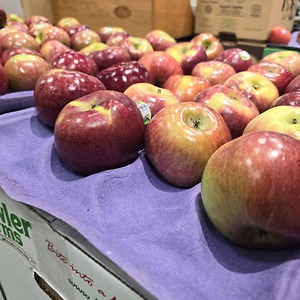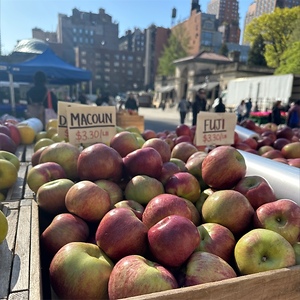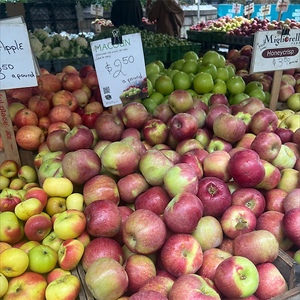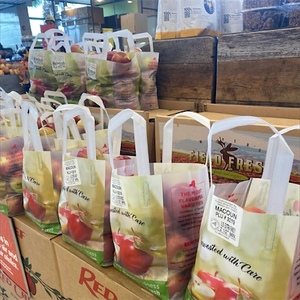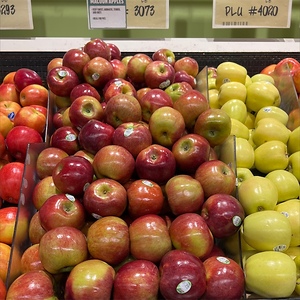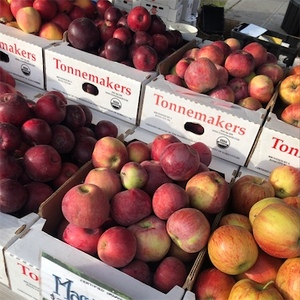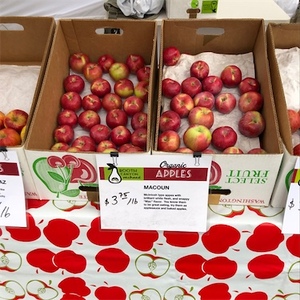

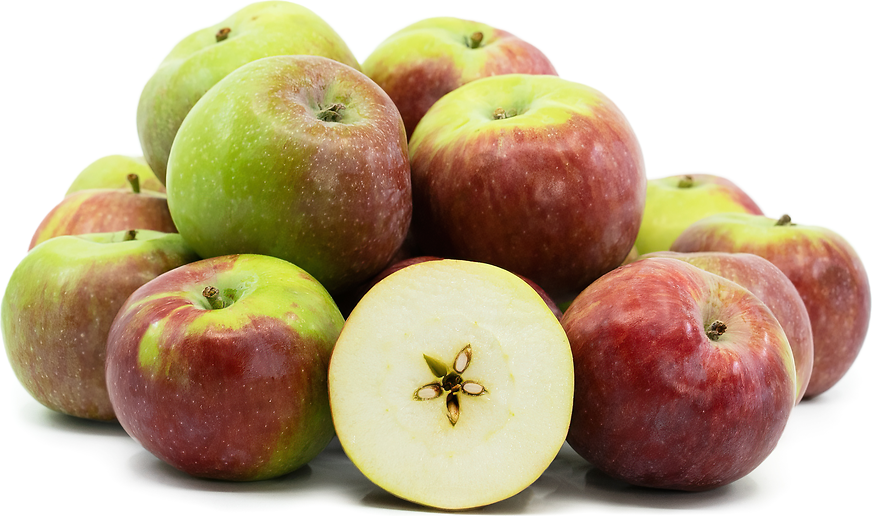
Macoun Apples
Estimated Inventory, lb : 0
Description/Taste
Macoun apples are a medium to large varietal, averaging 6 to 8 centimeters in diameter, and have an irregular, round, conic, or oblate shape. The apples are often ribbed, creating an angular, boxy appearance, and the stems are characteristically short with a woody, green-brown stem in a shallow cavity. The apple’s skin is semi-thick, tough, smooth, and taut, showcasing prominent, light tan lenticels across the surface. The skin also has a green base hue with a faint sheen and is covered in a dark red, crimson, and burgundy blush. In some growing environments, the fruits may develop a blue-grey bloom on the surface that can be easily removed when wiped. Underneath the surface, the white flesh is tinged with green and is firm, aqueous, and fine-grained with a crisp, tender, and succulent consistency. The flesh also bruises easily and encases a moderate-sized core filled with black-brown seeds. Macoun apples are aromatic and have high sugar mixed with acidity, creating a sweet, tart, and subtly acidic taste with floral, vinous, spice-filled, and berry-like undertones.
Seasons/Availability
Macoun apples are harvested in the late fall through early winter.
Current Facts
Macoun apples, botanically classified as Malus domestica, are an American variety belonging to the Rosaceae family. The mid to late-season fruits grow on small deciduous trees reaching 3 to 4.8 meters in height and are an improved McIntosh-type apple developed for fresh eating. Macoun apples were released in the early 20th century and quickly became a favored cultivar among apple enthusiasts in the northeastern United States. The apples have a complex flavoring and juicy nature derived from its McIntosh parent combined with a dark red, pigmented coloring and boxy shape from its Jersey Black parent. Despite their avid following amongst consumers in the northeast, Macoun apples are not commercially cultivated due to their challenging growth characteristics and short season. The variety is only available for a few weeks each year, and the apples have a short shelf life, requiring them to be eaten straight from the tree for the best quality and flavor. Macoun apple trees are hardy, vigorous and must be thinned to produce viable crops. The trees are somewhat resistant to cedar-apple rust and fire blight but suffer from biennial bearing, depending on the growing environment and thinning. Macoun apples also have a short stem, causing the fruits to be pushed off of the tree before they are ripe, leading to premature drop. Growers must hand harvest the fruits to prevent dropping and bruising, and the apples must be sold immediately before they begin softening. In the modern day, Macoun apples are a seasonal delicacy treasured among consumers in the Midwest and Northeastern United States. The fruits were intended as a fresh eating variety, but over time, they became popular for baking, turning the specialty apples into an all-purpose cultivar.
Nutritional Value
Macoun apples are a source of magnesium to control nerve functioning, fiber to regulate the digestive tract, calcium to build strong bones and teeth, and vitamin C to boost the immune system. The variety also provides potassium to balance fluid levels within the body, vitamin E to reduce inflammation, vitamin A to maintain healthy organ functioning, iron to develop the protein hemoglobin to transport oxygen through the bloodstream, and other nutrients, including calcium, phosphorus, zinc, copper, boron, and magnesium. The apple’s red-hued skin indicates the presence of anthocyanins, natural pigments with antioxidant-like properties to protect the cells against the damage caused by free radicals.
Applications
Macoun apples have a sweet, tart, and berry-like taste suited for fresh and cooked preparations. When the variety was first released, it was designated as a fresh-eating apple, leading it to be consumed straight out of hand as a snack or healthy dessert. Macoun apples can also be chopped into salads, sliced as an accompaniment to sharp cheeses on charcuterie boards, or cut and served as an edible garnish over pancakes, toast, porridge, or parfaits. The variety is slow to brown, allowing it to be used on crostini for appetizers, layered into sandwiches, or used as a snack dipped in caramel, nut butter, and chocolate. In addition to fresh preparations, Macoun apples hold their shape when heated and have become a popular cooking apple. The fruits are incorporated into pies, tarts, muffins, cakes, and bread, baked into dumplings, fried into fritters, or simmered into jams, jellies, and preserves. Macoun apples are also cooked into sauces, roasted with root vegetables as a savory side, or sauteed in browned butter as a topping for desserts. Macoun apples pair well with cheeses such as gorgonzola, feta, and gouda, nuts including walnuts, pine, and almonds, meats such as bacon, poultry, and turkey, vanilla, heavy cream, and spices including nutmeg, cloves, allspice, cardamom, and cinnamon. Whole, unwashed Macoun apples will keep for 1 to 2 weeks when stored in the refrigerator’s crisper drawer. The apples have a short shelf life and should be immediately consumed after harvest for the best quality and flavor.
Ethnic/Cultural Info
Macoun apples were named after Canadian pomologist William Terrill Macoun. There is some debate over how the apple’s name is supposed to be pronounced, with growers saying “Ma-cow-an,” “Ma-coon,” and “MacCowan.” The most generally accepted pronunciation among pomologists is “MacCowan.” William Terrill Macoun, often known as W.T. Macoun, was a famous Canadian fruit breeder passionate about apples. Macoun was a horticulturalist at the Central Experimental Farm near Ottawa, Canada, from 1989 to 1932, and he was also the founder of the Ontario Horticultural Association. During his career, Macoun collaborated with other breeders to release other well-known commercial varieties, including Empire, Cortland, and Spartan. He also notably partnered with William Saunders and received honors for their work of hybridizing at least 16 varieties and naming over 105 apple cultivars.
Geography/History
Macoun apples are native to the United States and were developed in Geneva, New York, at the New York Agricultural Experimental Station in 1909. Scientist and breeder Richard Wellington crossed Jersey Black apples with McIntosh apples to create Macoun apples, and the variety was released to the public in 1923. Wellington selected Macon apples as a fresh-eating cultivar, and after their release, apple enthusiasts began sourcing the apples for baked goods once they discovered the fruits hold their shape when heated. Macoun apples never became a widespread cultivar, but the apples did find a niche market as a specialty fruit that is only sold for a limited season. The apples are an anticipated variety each fall in the Northeastern United States and are primarily grown in cooler climates, localized to parts of the Midwest and Northeast, such as New York, New England, Rhode Island, Vermont, and Massachusetts. Today, Macoun apples are challenging to find as they are only available for a short season and are generally sold directly through growers, roadside stands, and at pick-your-own orchards in the United States.
Recipe Ideas
Recipes that include Macoun Apples. One
| Cooking with Books |
|
Morning Glory Farm's Apple Brandy Cake |
| Bonapetit |
|
Apple Vichyssoise |
| The Butcher and The Baker |
|
Crumble-Top Macoun Apple Pie |
| Not Eating Out In New York |
|
Apple Upside-Down Cake |



